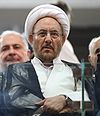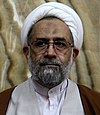This article has multiple issues. Please help improve it or discuss these issues on the talk page. (Learn how and when to remove these messages)
|
| وزارت اطّلاعات جمهوری اسلامی ایران Vezarat-e Ettela'at Jomhuri-ye Eslami-ye Iran | |
 | |
 Flag of the Ministry of Intelligence Flag of the Ministry of Intelligence | |
| Agency overview | |
|---|---|
| Formed | 18 August 1983; 41 years ago (1983-08-18) |
| Preceding agency | |
| Jurisdiction | Government of the Islamic Republic of Iran |
| Headquarters | Hirmand Street, Pasdaran, Tehran |
| Employees | Classified (30,000 by estimation of Magnus Ranstorp) |
| Agency executive |
|
| Website | vaja.ir |
| Politics of Iran |
|---|
 |
| Government of Islamic Republic of Iran |
|
Leadership
|
| Executive |
|
Legislative
|
| Judicial |
| Supreme Councils |
| Local governments |
Elections
|
Political parties and factions
|
| Intellectual backdrop |
|
Foreign relations
|
| Related topics |
The Ministry of Intelligence of the Islamic Republic of Iran (Persian: وزارت اطّلاعات جمهوری اسلامی ایران, romanized: Vezarat-e Ettela'at Jomhuri-ye Eslami-ye Iran) is the primary intelligence agency of the Islamic Republic of Iran and a member of the Iran Intelligence Community. It is also known as VAJA and previously as VEVAK (Vezarat-e Ettela'at va Amniyat-e Keshvar) or alternatively MOIS. It was initially known as SAVAMA, after it took over the Shah's intelligence apparatus SAVAK. The ministry is one of the three "sovereign" ministerial bodies of Iran due to nature of its work at home and abroad.
History
Reliable and valid information on the ministry is often difficult to obtain. Initially, the organization was known as SAVAMA, and intended to replace SAVAK, Iran's intelligence agency during the rule of the Shah, but it is unclear how much continuity there is between the two organizations—while their role is similar, their underlying ideology is radically different. It is suspected that the new government was initially eager to purge SAVAK elements from the new organization, but that pragmatism eventually prevailed, with many experienced SAVAK personnel being retained in their roles. Former SAVAK staff are believed to have been important in the ministry's infiltration of left-wing dissident groups and of the Iraqi Ba'ath Party.
The formation of the ministry was proposed by Saeed Hajjarian to the government of Mir-Hossein Mousavi and then the parliament. There were debates about which branch of the state should oversee the new institution, and the other options apart from the presidency were the Judiciary system, the Supreme Leader, and Islamic Revolutionary Guard Corps. Finally, the government got the approval of Ayatollah Khomeini to make it a ministry, but a restriction was added to the requirements of the minister: that he must be a doctor of Islam.
The ministry was finally founded on 18 August 1983, either abandoning, silently subsuming, or relegating to hidden existence many small intelligence agencies that had been formed in different governmental organizations. The five ministers since the founding of the ministry, have been Mohammad Reyshahri (under Prime Minister Mir-Hossein Mousavi), Ali Fallahian (under President Ali Akbar Hashemi Rafsanjani), Ghorbanali Dorri-Najafabadi (under President Mohammad Khatami, resigned after a year), Ali Younessi (under President Khatami, until 24 August 2005), Gholam Hossein Mohseni-Ejehei (under President Mahmoud Ahmadinejad, from 24 August 2005 to 24 August 2009) and Heyder Moslehi (under President Mahmoud Ahmadinejad, from 29 August 2009 to 15 August 2013).
"Chain" assassinations
Main article: Chain murders of IranIn late 1998, three dissident writers, a political leader and his wife were killed in Iran in the span of two months.
After great public outcry and journalistic investigation in Iran and publicity internationally, prosecutors announced in mid-1999 that one Saeed Emami had led "rogue elements" in Iran's intelligence ministry in the killings, but that Emami was now dead, having committed suicide in prison. In a trial that was "dismissed as a sham by the victims' families and international human rights organisations", three intelligence ministry agents were sentenced in 2001 to death and twelve others to prison terms for murdering two of the victims. Two years later, the Iranian Supreme Court reduced two of the death sentences to life.
Foreign executions
Massoud Molavi Verdanjani, an online opposition activist, was shot and killed on a street in Istanbul's Şişli neighborhood on Thursday, 14 November 2019. A Turkish security official later claimed Verdanjani's suspected killer had confessed to acting under the orders of two Iranian intelligence officers at the Iranian consulate in Turkey.
On 20 April 2022, According to a statement issued by the semi-official Fars news agency, Iran's intelligence ministry stated it had captured three Mossad spies.
Financials
The ministry received a ten fold increase in fundings in 2024.
List of ministers
| No. | Portrait | Minister | Took office | Left office | Time in office | Head of government |
|---|---|---|---|---|---|---|
| 1 |
 | Reyshahri, MohammadMohammad Reyshahri (1946–2022) | 15 August 1984 | 29 August 1989 | 5 years, 14 days | Mir-Hossein Mousavi |
| 2 |
 | Fallahian, AliAli Fallahian (born 1949) | 29 August 1989 | 20 August 1997 | 7 years, 356 days | Akbar Hashemi Rafsanjani |
| 3 |
 | Dorri-Najafabadi, GhorbanaliGhorbanali Dorri-Najafabadi (born 1950) | 20 August 1997 | 9 February 1999 | 1 year, 173 days | Mohammad Khatami |
| 4 |
 | Younesi, AliAli Younesi (born 1955) | 9 February 1999 | 24 August 2005 | 6 years, 196 days | Mohammad Khatami |
| 5 |
 | Mohseni-Eje'i, Gholam-HosseinGholam-Hossein Mohseni-Eje'i (born 1956) | 24 August 2005 | 26 July 2009 | 3 years, 331 days | Mahmoud Ahmadinejad |
| – |
 | Majid Alavi Acting | 26 July 2009 | 26 July 2009 | 1 day | Mahmoud Ahmadinejad |
| – |
 | Mahmoud Ahmadinejad (born 1956) Acting | 28 July 2009 | 3 September 2009 | 67 days | Himself |
| 6 |
 | Moslehi, HeydarHeydar Moslehi (born 1957) | 3 September 2009 | 15 August 2013 | 4 years, 23 days | Mahmoud Ahmadinejad |
| 7 |
 | Alavi, MahmoudMahmoud Alavi (born 1954) | 15 August 2013 | 25 August 2021 | 8 years, 10 days | Hassan Rouhani |
| 8 |
 | Khatib, EsmaeilEsmaeil Khatib (born 1961) | 25 August 2021 | Incumbent | 3 years, 134 days | Ebrahim RaisiMasoud Pezeshkian |
See also
References
- "How Iran would retaliate if it comes to war". The Christian Science Monitor. 20 June 2008.
- al Labbad, Mustafa (15 August 2013). "Rouhani's Cabinet Seeks New Balance in Iranian Policies". Al-Monitor. Retrieved 17 December 2014.
- "Iran – SAVAMA". country-data.com.
- "SAVAMA – Sazman-E Ettela'at Va Amniat-E Melli-E Iran (Ministry of Intelligence and National Security, Iranian intelligence organization that replaced the Shah's SAVAK) | AcronymFinder". acronymfindeلبیک یا خامنه ایr.com.
- Douglas, Jehl (4 December 1998). "Killing of 3 Rebel Writers Turns Hope to Fear in Iran". The New York Times. p. A6. Retrieved 17 December 2014.
- Sahebi, Sima (12 December 2002). "You will answer, one day". Iranian.com. San Francisco. Retrieved 17 December 2014.
- "Ganji identified Fallahian as the 'master key' in chain murders". Iran Press Service. Archived from the original on 28 April 2013.
- "Iranian killers spared death penalty". Middle East: BBC News. 29 January 2003. Retrieved 17 December 2014.
- "Iran – 2003 Annual report". Reporters Sans Frontières (Reporters Without Borders). 7 April 2003. Retrieved 17 December 2014.
- "Exclusive: Iranian diplomats instigated killing of dissident in Istanbul, Turkish officials say". Reuters. 27 March 2020.
- "Iranian Diplomats Instigated Killing of Dissident in Istanbul, Turkish Officials Say". Radio Farda. 28 March 2020.
- "Iran arrests three Mossad spies, does not specify their nationalities -Fars news agency". Reuters. 20 April 2022. Retrieved 24 April 2022.
- "Tenfold rise in intelligence ministry's budget raises eyebrows in Iran".
- Rotella, Sebastian (30 July 2012), "Before Deadly Bulgaria Bombing, Tracks of a Resurgent Iran-Hezbollah Threat", The Foreign Policy, retrieved 3 June 2016
- Alfoneh, Ali (5 August 2009), "Iran's Velvet Revolution Within", American Enterprise Institute, retrieved 3 June 2016
- Milani, Abbas (3 August 2009). "Inside The Civil War That's Threatening The Iranian Regime". The New Republic. Retrieved 3 June 2016.
Further reading
- Yves Bonnet, Vevak, au service des ayatollahs: Histoire des services secrets iraniens, Timée-éditions, Boulogne-Billancourt, 2009. ISBN 978-2-35401-001-0. (in French)
External links
| Intelligence Ministers of Iran | ||
|---|---|---|
|  | |
| Acting | ||
| National intelligence agencies | |
|---|---|
| Foreign intelligence |
|
| Domestic intelligence |
|
| Military intelligence |
|
| Signals intelligence |
|
| Imagery intelligence | |
| Financial intelligence |
|
| Criminal intelligence |
|
| Intelligence community | |
| Intelligence alliances | |
| Defunct agencies | |
| Related topics | |
35°45′04″N 51°27′25″E / 35.751°N 51.457°E / 35.751; 51.457
Categories: